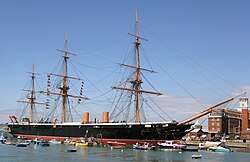HMS Warrior (1860)
|
||||||||||||||||||
|
||||||||||||||||||
|
||||||||||||||||||
|
||||||||||||||||||
|
||||||||||||||||||
The HMS Warrior from 1860 was the first ocean-going armored ship with an iron hull. It was built by the British Royal Navy as a countermeasure to the French ironclad La Gloire . She gave her name to the ship class of the same name and was the sister ship of the HMS Black Prince . She is now a museum ship in Portsmouth .
history
When it was launched, its 4.5 inch (11.43 cm) thick forged iron belt made it virtually invulnerable to the projectiles of the naval artillery in use at the time of its construction. In order to improve the descent safety even further, the hull was divided into 92 watertight compartments and had a double floor underneath the machinery and ammunition rooms. The only significant vulnerability was the lack of armor around the steering gear, so an unfortunate hit could have rendered it unable to maneuver.
The main drive of the ship consisted of a horizontal two-cylinder steam engine from Penn , which was supplied with steam by ten boilers. However, the coal consumption was extremely high and the 850 t of coal on board were only sufficient for a distance of almost 2,100 nm under optimal conditions. Therefore the Warrior continued to have full rigging as a full ship with a sail area of 4,500 m². If she drove under sails, then both chimneys could be drawn in so as not to hinder the handling of the sails. The propeller could be pulled into the hull when sailing under sail in order to reduce the water resistance. In practice, however, it continued to run at slow speed, as coupling and uncoupling the shaft to the screw was quite tedious.
When it was to be launched on December 29, 1860 at the Thames Ironworks near London, it froze on the slipway . That was the coldest winter in 50 years. The Warrior was completed on October 24, 1861. The total cost was £ 357,291.
The HMS Warrior was a battery ship - the cannons were arranged in side batteries and could only shoot to the side. It was planned to equip the ship with 36 cannons. When commissioned, however, she was armed with 26 68-pounders muzzleloaders , 10 110-pounders Armstrong cannons and 4 40-pounders Armstrong cannons. In 1863 the 40 pounders were replaced by improved cannons of the same caliber. From November 22, 1864 to July 25, 1867 the ship was overhauled. Here she was provided with 4 8-inch cannons, 24 7-inch cannons and 4 20-pounders ( salute cannons ). The rapid advances in marine technology made her and her sister ship Black Prince obsolete within 10 years. On April 1, 1875, she was assigned to the first reserve fleet and withdrawn from sea service on May 31, 1883. From January 17, 1884, their cannons and the upper masts were removed in Portsmouth.
Her hull was used as a warehouse, and from 1902 to 1904 she served as a depot for a cruiser flotilla. Her name was changed to Vernon III in 1904 when she was taken to Vernon Torpedo Training School . It supplied the hulls lying there with steam and electricity. In October 1923 it was given its old name Warrior again.
A downturn in scrap demand meant that it could not be sold for scrapping as planned on April 25, 1925. Since 1929 she has been in the Pembroke Dock naval shipyard in Wales as a floating oil investor. She stayed there for the next 50 years. On August 27, 1942, it was renamed again in Oil Fuel Hulk C77 , as the name Warrior was now intended for the light aircraft carrier HMS Warrior (R31) of the Colossus class, which was under construction .
The restoration of the museum ship began on September 3, 1979 in Hartlepool and was completed in 1984. Then she was towed to her present berth in Portsmouth . It was renamed Warrior (1860) to avoid confusion with the Royal Navy headquarters of the same name in Northwood.
Captains
- Captain Arthur A. Cochrane, August 1, 1861 - November 22, 1864
- Rear Admiral Charles Frederick March 31, 1865 - July 25, 1867
- Captain Henry Boys, July 25, 1867 - August 21, 1869
- Captain Frederick H. Stirling, August 21, 1869 - February 22, 1870
- Captain HC Glyn, February 22, 1870 - March 15, 1875
- Captain William H. Whyte, March 15, 1875 - March 15, 1878
- Captain R. Gordon Douglas, March 15, 1878 - June 5, 1878
- Rear Admiral Henry Boys, June 5, 1878 - November 25, 1879
- Captain Samuel P. Townsend, November 25, 1879
See also
- Sir George Tryon , 10 August 1861 - 10 September 1864, Deputy Commander of the Warrior , later Commander in Chief of the British Mediterranean Fleet
literature
- Andrew Lambert: Warrior, restoring the World's First Ironclad . Conway Maritime Press, London 1987. ISBN 0-85177-411-3 .
- Navy List , 1860-1920
- Riccardo Magrini: Ships. Sailing ships, warships, passenger and merchant ships , Fränkisch-Crumbach 2016, p. 94, ISBN 978-3-8468-0022-5
Web links
Coordinates: 50 ° 47 '54 " N , 1 ° 6' 34" W.
